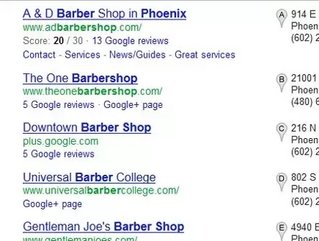Start Crushing Local Search Results by Knowing the Algorithm

By: Justin McGill
If you go to a search result and look for products or services around you, which is now happening about 30% of the time, you will see map marker icons next to business listings (see a search below for barbers in Phoenix, AZ).
.jpg)
These are local listings and they are all the rage these days. It gives the user quick access to ratings and reviews, contact information, and an address (along with a map) to give an indication of how far away something is. Like regular search results, you want to be higher up the list in order to get more clicks on your listing.
The Evolution of Local Search
In 2004, Google originally rolled out “Google Local” which gave local business information to searchers.
What Google Looked Like Back Then:

In 2005 Google Maps was designed to simplify directions to these local listings. Fast forward to 2009 and Google rolled out their local business center dashboard which showed you impressions your listing has received as well as actions (which could include calls, clicks for directions, etc). Unfortunately, this dashboard has yet to be upgraded and will often times show inaccuracies (more actions than impressions for instance).
Read related content:
- Understanding SEO in 2013
- Branding and Your Website
- Phoenix, Arizona: An Emerging Metropolis among Picturesque Landscapes
In 2010 Google Local officially became known as Google Places. At this time 20% of all searches were for local results and they had over 4 million businesses claimed. Local search ad revenue was just over 5 billion. By May 2012 the name was officially changed to Google+ Local (to coincide with their social network Google+). Ad revenue is expected to exceed 8 billion next year from local search.
Why Local Search Matters
A few years ago 1 in 5 searches had local intent, and now that number is 1 in 3. This will continue to increase with the rising usage of smartphones. If your business is local in nature and cannot be found when someone is doing a search – you are missing out on these customers to your competitors.
Key Local Ranking Factors
So how are your competitors outranking you? Chances are they have many of these things in their favor:
1. Quantity of Structured Citations
What This Means: Have your business information in as many relevant directories as possible. Here is a good list to start with: http://searchengineland.com/top-50-citation-sources-for-uk-us-local-businesses-104938
2. Domain Authority of Website
What This Means: Having some SEO and credibility built with your actual website domain will also help not only your organic rankings for other keywords, but also your local listing. Get some blogs and other websites to mention you, be more active with your social media, have your friends link to you from their websites, etc. The more links and references of you found online the better.
3. Consistent Name, Address, and Phone # in All Listings and Matching Your Website
What This Means: This is critical that ALL of your citations have the exact same matching Name, Address, and Phone number. Inconsistencies can hurt your rankings.
4. Proper Selection of Categories
What This Means: You can choose up to 5 relevant categories for your business when setting up your Google+ Local listing so make them count.
5. Owner Verified
What This Means: This is the easiest thing you can do if you haven’t already. Claim the listing! They will send you a post card or give you a call with a pin code that you enter to verify you are the owner of the business.
6. Positive Reviews
What This Means: Google doesn’t want to promote bad business practices so the more quality reviews you can get the better. Always ask your customers to leave a review if they are satisfied. If you know they aren’t satisfied – then don’t ask them to leave a review and work on ways in which next time you can leave your customers happy!
7. Use of high quality photos and videos
What This Means: Take good photos and put up any videos you have. This helps your profile look more complete and something Google will favor showing versus incomplete listings.
You can see a complete list of variables here by David Mihm (http://www.davidmihm.com/local-search-ranking-factors.shtml) who has been putting this research and conducting surveys with local marketing experts.
Although I outlined 7 things above that you can control, there are many other factors which are out of your control (distance from the location of the search for one, age of your domain/listing, etc). I suggest putting major emphasis on the factors you can control with your marketing efforts. It is worth the time and money in the long run as you start taking more of the market share from your competitors.
Author Bio
Justin McGill is the CEO and Founder of SEORCHERS, a local marketing and lead generation company and helps businesses connect to residents at local apartment communities through PadPerks. Connect with him on LinkedIn or find him on Google+.






